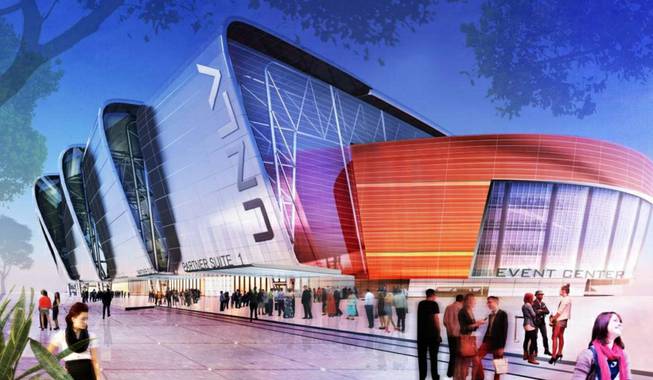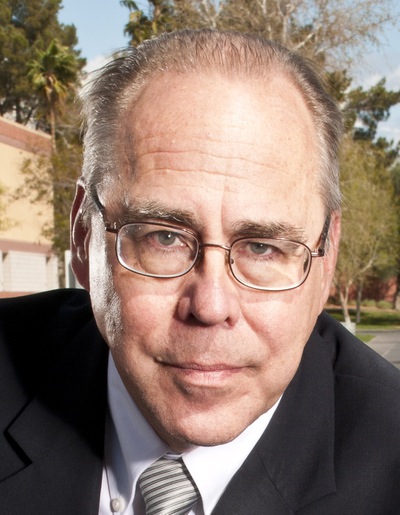
Majestic Realty Co.
UNLV Now mega events center rendering.
Thursday, Nov. 21, 2013 | 7:30 p.m.
One day after news came out of Neal Smatresk’s impending departure, a campus improvement board met to discuss how it hopes to carry on the UNLV president’s legacy project: an on-campus football stadium.
For the past three years, Smatresk has been the biggest champion of a UNLV stadium that would host football games and some of the biggest events in Las Vegas. A UNLV stadium, Smatresk argued, could bolster the university’s campus life and potentially infuse hundreds of millions of dollars into the local economy.
Now that Smatresk plans to become the next president of the University of North Texas — pending final approval in December — he won’t be around to see his vision for a UNLV stadium come to fruition.
In Smatresk’s absence, a group of 11 campus, government and resort industry leaders is tasked with bringing the departing president’s vision to life.
On Wednesday, the UNLV Campus Improvement Authority Board began discussing in earnest the kind of stadium they envision. The project’s size and scope has changed several times over the past several years, but with the creation of the stadium authority, UNLV officials hope to “dial in” a stadium concept that benefits UNLV and also the resort industry and Southern Nevada.
“We have an opportunity to do something game-changing, something that fits into the long-term vision of our campus,” said Don Snyder, stadium authority chairman and UNLV’s point man on the stadium project. “From the university’s point of view, the most important thing we can do is to have an on-campus, state-of-the-art, collegiate stadium that is a catalyst for the transformation of the university and meets its aspirational goals.”
For three hours, stadium authority members reviewed the campus master plan and deliberated several major questions the board will need to answer:
• Will the stadium be covered or open air?
• How many seats will it have?
• What kind of amenities and features should it have?
The answers to these key questions will come from several studies that will need to be completed in the next several months before the board can deliver a recommendation to the Legislature in September 2014.
The authority’s vision for the UNLV stadium lies somewhere between a traditional college football stadium on campus to something a tad bit smaller than the UNLV Now stadium concept that was proposed by UNLV’s former private developer partner Majestic Realty. The concept for a $900 million, 60,000-seat, mega-events center with the world’s largest video screen and “super-clubs” for VIP fans is out of the question.
Majestic’s plan went beyond the university’s needs, and competed with the Strip community for events, stadium officials said.
“Personally, I think mega-events is not right,” said Chris Giunchigliani, a Clark County commissioner and stadium authority member. “We need to complement the university and resorts, not compete with them.”
However, the university hopes to see at least an “on-campus, state-of-the-art, collegiate stadium” built, Snyder said.
“That, at minimum, is what needs to come out of this process,” Snyder said. “To the extent it goes beyond that, that will serve the community as a whole and the resort community.”
Stadium authority member and Regent Michael Wixom said the UNLV stadium should go beyond just an on-campus version of Sam Boyd Stadium in the eastern valley, where UNLV football currently plays. To pay for the construction, operation and maintenance costs, a UNLV stadium ought to be large enough to generate enough revenue, Wixom said.
“We cannot generate enough revenue from football to pay for the stadium. It’s impossible,” Wixom said. “It has to be something iconic, something quintessentially Las Vegas. Otherwise, we don’t have the wherewithal to pay for it.”
The stadium authority board is looking to bring back University of Michigan professor and stadium consultant Mark Rosentraub to outline several configurations for the new UNLV stadium: covered or uncovered, and a range of seating, perhaps between 40,000 and 55,000 seats.
In addition, the stadium board is looking to commission several other studies, including one that looks at on-campus parking and traffic in and around the proposed location of the stadium, near Harmon Avenue and Swenson Street. After a project manager is hired in January, further studies that look at revenue streams and construction costs will need to be completed.
However, as the board moves forward with its stadium discussions, the steadfast presence of Smatresk will be missed, Snyder said.
“Neal knew having the football stadium on campus was critical to help the university move to the next level academically and athletically, and in terms of creating a residential campus,” Snyder said. “If it hadn't been for Neal and his focus on doing the things that allow the university to move to a higher level, I don’t think this project would have gotten wind under its wings to move forward.”


Join the Discussion:
Check this out for a full explanation of our conversion to the LiveFyre commenting system and instructions on how to sign up for an account.
Full comments policy